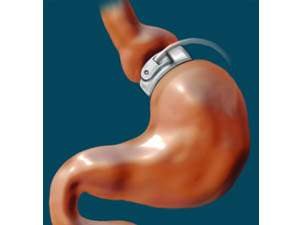Types of Gastric Band
A form of bariatric surgery which reduces the size of your stomach by using a silicone band is known as Adjustable Gastric Band (AGB) surgery. Weight loss occurs since your smaller stomach is not able to hold as much food. Over time, the amount of weight you lose is controlled by your doctor who adjusts the band, either tightening or loosening it to allow for an increase or decrease in weight lost. There are a variety of bands used to accomplish this and it is important to learn as much as you can about them before deciding with your doctor which is the best for you.
Developed in 1984 by Professor Dag Hallberg, the Swedish band was the first known adjustable gastric band, according to the experts at Obesity Surgery. By 1985, he received his patent, however it was only available in Sweden, Denmark and Norway. According to the experts at Weight Loss Surgery, it became available worldwide in 1996. The Swedish band works by separating your stomach into two sections by placing the band around the uppermost section of your stomach as is true of most AGBs. It either allows more food or less food to enter your lower stomach as required by being tightened or loosened as required. You ultimately lose weight less since the upper portion of the stomach fills up with food quickly before passing through, you feeling satiated sooner, which helps you eat less. The balloon used to make these adjustments lines the entire band, making the band more flexible for this process than some other bands on the market.
Soon after Professor Hallberg received his Swedish patent for the band, Lubomir Kuzmak, an American doctor, designed what has become known as the Lap-Band. Dr. Kuzmak applied for his patent in 1985, according to Obesity Surgery. The difference, however was that unlike Professor Hallberg, Kuzmak's patent was for the United States only. Although the Lap-Band has since been redesigned, it could only be adjusted a maximum of two millimeters originally, and thus was not very flexible. It can now be adjusted 7 to 8 millimeters. According to the Lap-Band Guide, the Lap-Band has been used in Europe since 1993, despite its American patent. In 2001, it received FDA approval to be used in the United States. Worldwide, more than 350,000 Lap-Band procedures have since been performed.
After the design and patent of the Lap-Band, the Midband was designed by Dr. Vincent Frering in Lyon, France. This band is inherently different in design from the Swedish Band and the Lap-Band. It has a larger balloon and is a bit shorter. Having had experience with both the Swedish and Lap-Bands, Dr Frering designed the Midband in this manner to provide a softer system. This helps to ensure that the band does not irritate the lining of the gastric wall, which prevents erosion and irritation of the band from occurring. In addition, the Midband does not have sharp edges as some of its counterparts do, and it is easily detected by X-rays, taking the guess work out of adjustments.
The Easyband is the newest addition to the gastric-band family and works like none other. The Easyband is purely technological. It does not require saline solution for deflation or inflation during adjustments of the balloon. Inside the band is a motor and microchip. When it is time to adjust your band, the doctor will use a handheld device resembling a remote control to locate the chip. Once located, he will send a signal to the chip, which tells the band to loosen or tighten. It must be noted that the Easyband is still experimental and there is currently no evidence to prove or dispel its effectiveness.

